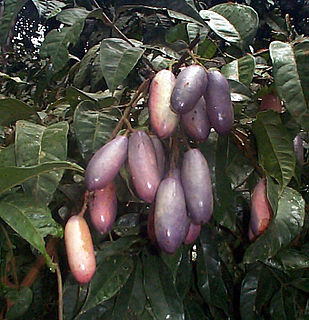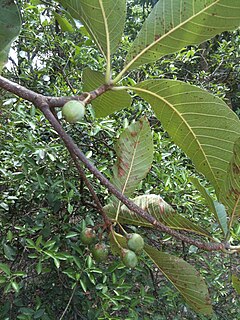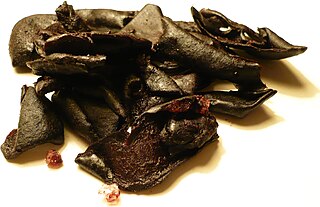
A triglyceride is an ester derived from glycerol and three fatty acids. Triglycerides are the main constituents of body fat in humans and other vertebrates, as well as vegetable fat. They are also present in the blood to enable the bidirectional transference of adipose fat and blood glucose from the liver, and are a major component of human skin oils.

The sunflower seed is the fruit of the sunflower. There are three types of commonly used sunflower seeds: linoleic, high oleic, and sunflower oil seeds. Each variety has its own unique levels of monounsaturated, saturated, and polyunsaturated fats. The information in this article refers mainly to the linoleic variety.

Vitellaria paradoxa, commonly known as shea tree, shi tree, or vitellaria, is a tree of the family Sapotaceae. It is the only species in the genus Vitellaria, and is indigenous to Africa.

Attalea maripa, commonly called maripa palm is a palm native to tropical South America and Trinidad and Tobago. It grows up 35 m (115 ft) tall and can have leaves or fronds 10–12 m (33–39 ft) long. This plant has a yellow edible fruit which is oblong ovoid and cream. An edible oil can be extracted from the pulp of the fruit and from the kernel of the seed.

A pumpkin seed, also known in North America as a pepita, is the edible seed of a pumpkin or certain other cultivars of squash. The seeds are typically flat and asymmetrically oval, have a white outer husk, and are light green in color after the husk is removed. Some cultivars are huskless, and are grown only for their edible seed. The seeds are nutrient- and calorie-rich, with especially high content of fat, protein, dietary fiber, and numerous micronutrients. Pumpkin seed can refer either to the hulled kernel or unhulled whole seed, and most commonly refers to the roasted end product used as a snack.

Canarium ovatum, the pili, is a species of tropical tree belonging to the genus Canarium. It is one of approximately 600 species in the family Burseraceae. C. ovatum are native to the Philippines. They are commercially cultivated in the Philippines for their edible nuts and is believed to be indigenous to that country. The fruit and tree are often vulgarized with the umbrella term of "Java almond" which mixes multiple species of the same genus, Canarium.

Macadamia oil is the non-volatile oil collected from the nuts of the macadamia, a native Australian plant. It is used in food as a frying or salad oil, and in cosmetic formulations as an emollient or fragrance fixative.

Apricot oil or apricot kernel oil is pressed from the kernels of the Prunus armeniaca (apricot). Apricot kernels have an oil content of 40-50%. The oil is similar to almond oil and peach oil, both of which are also extracted from the kernels of the respective fruit.
Candlenut oil or kukui nut oil is extracted from the nut of Aleurites moluccanus, the candlenut or kuku'i.

Astrocaryum murumuru is a palm native to Amazon Rainforest vegetation in Brazil, which bears edible fruits. Murumuru butter, extracted from the seeds of the plant, may be used as a moisturizer.

Dacryodes edulis is a fruit tree native to Africa, sometimes called safou (Cameroon), atanga, ube (Nigeria), African pear, bush pear, African plum, nsafu, bush butter tree, or butterfruit.

Marula oil is extracted from the kernels (nuts) of the fruits of the Marula trees, from the family Anacardiaceae. There are two types of marula oil, the oil extracted from the seeds and the oil extracted from the nut's hard shell. Marula oil is traditionally used in cosmetics, in food as a cooking oil, and as a meat preservative and to treat leather.

Virola surinamensis, known commonly as baboonwood, ucuuba, ucuhuba and chalviande, is a species of flowering plant in the family Myristicaceae. It is found in Brazil, Costa Rica, Ecuador, French Guiana, Guyana, Panama, Peru, Suriname, and Venezuela. It has also been naturalized in the Caribbean. Its natural habitats are subtropical or tropical moist lowland forests, subtropical or tropical swamps, and heavily degraded former forest. Although the species is listed as threatened due to habitat loss by the IUCN, it is a common tree species found throughout Central and South America.

Cucumeropsis mannii is a species of melon native to tropical Africa west of the East African Rift, where it is grown for food and as a source of oil.
Hydnocarpus wightianus or chaulmoogra is a tree in the Achariaceae family. Hydnocarpus wightiana seed oil has been widely used in Indian medicine and Chinese traditional medicine for the treatment of leprosy. It entered early Western medicine in the nineteenth century before the era of sulfonamides and other antibiotics for the treatment of several skin diseases and leprosy. The oil was prescribed for leprosy as a mixture suspended in gum or as an emulsion.

Diploknema butyracea, the Indian butter tree, is a multi purpose tree. Fat is extracted from the seeds and named chiuri ghee or phulwara butter. D. butyracea is useful for block planting and also to be grown in the ravines of hills. The latex yielding plant such as D. butyracea suits to different edapho climatic conditions and thus does not compete with the traditional crops. It is a large tree of family Sapotaceae, flowers during cold season and fruit ripens in June–July. It commonly occurs in the sub Himalayan tract between 300-1500m from sea level. The chiuri tree has been utilised for many uses by rural households in Nepal. Ghee is used in daily cooking, as fuel for lamps, and body lotion; the fruit is eaten fresh and use for alcohol distillation, oil-cakes are utilised as manure, and the tree itself is used as firewood, etc. It has significant cultural and livelihood associations with the Chepang community (Nepali:चेपांग) of Nepal and are given as dowry to daughters. This is not commercially farmed though.
Vateria indica oil is extracted from the seeds of the Vateria indica plant, a species in the family Dipterocarpaceae. The Vateria indica plant is indigenous to the Western Ghats, Kerala and Tamil Nadu regions of India. It thrives in the evergreen forests, surviving up to 800 meters above sea level. Oil from the seeds of the plant is extracted through a chemical refining process which makes the plant edible.

Nagkesar oil is extracted from seeds of the nagkesar tree. It belongs to the Calophyllaceae family. It is an East Indian evergreen tree and is often planted as an ornamental for its fragrant white flowers that yield a perfume. It is the source of hardwood used for railroad ties. It is Sri Lanka's national tree.

Shorea robusta seed oil is an edible oil extracted from the seeds of Shorea robusta. Shorea robusta is known as the Sal tree in India. Sal is indigenous to India and occurs in two main regions separated by the Gangetic Plain, namely the northern and central Indian regions. The plant belongs to the Dipterocarpaceae botanical family.

Kokum oil is a seed oil derived from the seeds of the kokum tree. Kokum oil is edible and can also be used for things other than cooking.



















